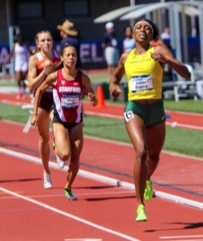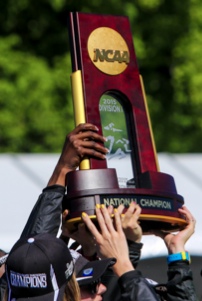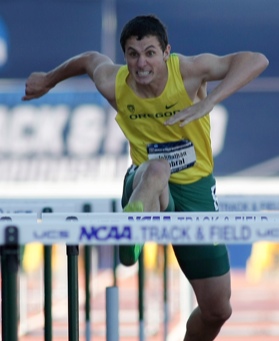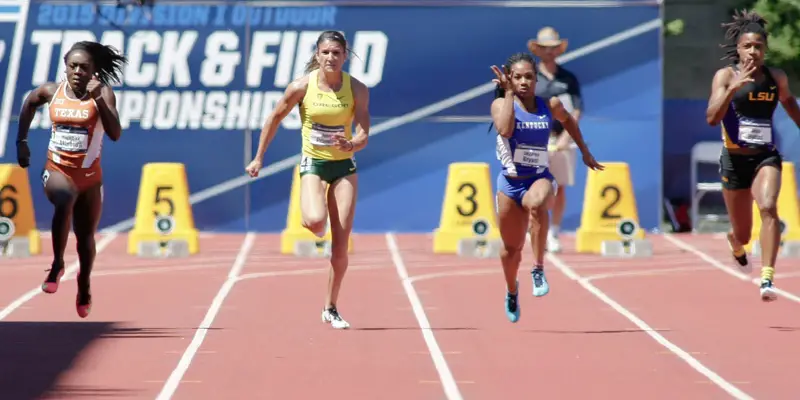Having attended track meets since the early ’60s, I’m not much of a fan of change in my favorite sport. However with the steep decline of the fan base over the past three or four decades, it has became apparent that something needed to be done to bring younger fans into the fold.
The old dual meets were a great way to recruit fans to the sport. Beat the Beavers! Annihilate the Huskies! Unfortunately, as athletic department budgets dwindled and Title IX dictated fewer scholarships for male tracksters while essentially splitting scholarships with female athletes (the real numbers are 18 for the women and 12.6 for the men), inevitably the dual meet became a thing of the past as schools had little money to travel and some fields dwindled to just an athlete or two per team.
While the Ducks still hold an annual triangular meet (the April Pepsi meet), the Oregon athletic department has had trouble recruiting opponents (again, that pesky travel budget issue) and let’s face it, a single triangular meet isn’t going to inspire a ton of fan support any more than a single football game would allow this publication to thrive. But championship programs will grow the fanbase.

Raevyn Roger’s incredible win.
Even Tracktown was rapidly losing its allure before Vin Lananna came onto the scene and delivered the 2008 Olympic Trials, which marked the resurgence of Tracktown USA. Vin also presided over the improvement of Duck men’s and women’s teams and the local track community responded with increased attendance at Hayward, despite the continuing lack of more than an annual competitive dual or triangular meet.
Vin has continued to bring great meets to Eugene and managed to convince the NCAA to hold collegiate track and field’s greatest event here through the 2021 NCAA finals. I could write another 5000 words on the Olympic Trials, 2016 Indoor Worlds, 2021 Outdoor Worlds and USATF Championship meets, but that’s another story.
Vin wasn’t content to merely cement Eugene’s reputation as TrackTown USA. He understood the dramatic decline in fan interest, especially that of the casual fan and embarked on a mission to bring track and field into more households by simplifying the ability to follow a track meet. Some of us oldsters scoffed since we know how to follow a track meet without being led by the hand, but most everyone agreed that something needed to be done since the current fan base is slowly dying off.
Vin’s big idea was to split the NCAA men’s and women’s championships into separate days, with the men commanding two days of the four day meet and the women taking over the remaining two days (there’s still a bit of overlap on days 1 and 2 when the multi events are staged).
Vin and crew were able to sell the idea to ESPN and instead of the minuscule couple of edited hours of the meet that would typically show up a week after the meet ended, ESPN agreed to cover the meet live for all four days, with the major parts of the meet condensed into two and a half hours, or roughly the time of most hockey, baseball, basketball or football games, thus fitting the meet finals into what might be deemed an acceptable time slot by most American sports fans.

Jenna Prandini
For those inclined to watch more than just a day or two of finals, the new TV contract allowed for no less than quadruple the TV coverage of any previous NCAA Track and Field Championship. The ratings aren’t in yet, but the potential exposure cannot be overlooked and should ESPN continue to broadly televise the meet in upcoming years, more fans should climb aboard.
So far, so good. But the main question in the minds of many track fans would be the effect on athletes whose performances were condensed from four days to two. Perhaps the best example would be Jenna Prandini, who was faced with a schedule that forced her to run a sprint relay at 4PM, a 100 meter semi at 5:15, a long jump final at 5:16 and a 200 semi at 6:14 on Thursday and then come back on Saturday with a 4×100 final at 2:05, a 100 meter final at 2:55, a 200 meter final at 3:40 and be ready for a 4×400 final at 4:20 (if necessary).
Many not only considered this unfair to sprinters, but dangerous for their bodies. Superstar sprinter Trayvon Bromell went on record stating that the athletes’ bodies were being subjected to the whims of TV broadcasts.
As a fan, my initial reaction was to suggest that coaches ditch sprint squad recruiting and concentrate on distance runners or throwers who experienced no dramatic effects from the new scheduling. However, once the meet played out, I realized how much easier it was to follow a three ring circus rather than the six ring circus the final long day had become with both men and women fighting for team titles.

Is television king over this?
Instead of slogging through 30 odd pages of form-charts and heat sheets, I was able to simply color code three pages of heat sheets and follow the meet much more easily. The introduction of a radio broadcast for certain field events was brilliant (several thousand fans were given earpieces as part of this experiment), with expert analysis and running commentary on team scores spread out over four channels.
Apart from television ratings and bringing new fans into the sport, my biggest concern would be “How would the new format affect the sprinters?” Sure, the Ducks have the equivalent of Superwoman in Jenna Prandini and she rose to the occasion, but what about the other traditional sprint powerhouses?
I’ve chosen to analyze the 100, 200, 400, 4×100 and 4×400 relays. I’ve left out the 100/110 hurdles since there aren’t too many who double and I’ll leave the sprinter/long jumper effect for another time. Here’s the effect on sprint powerhouse schools. The first number represents the TFN projected points and the second number represents actual points. In some cases, injuries or disqualifications caused adjustments to the scoring.
Men: Women:
USC 23/25 Oregon 23/18
Texas A&M 36/6 Texas A&M 25/27
LSU 30/25 Texas 41/23
Baylor 16/14 USC 22/21
Florida 30/19 Florida 30/23
Florida State 8/5 Kentucky 9/18
For the top schools, 224 out of 293 projected points were scored, a ratio of 76.45%. These numbers are meaningless without comparison to previous years. I was able to access the TFN form chart archive for 2012-2014, or three years under the old scheduling.
Analyzing the top sprint schools each year and projected points vs total points, the ratio is an astonishing 95.7%. It appears to be fairly obvious that the new system is hugely detrimental to sprinters and the schools they represent. Changes are necessary to protect sprinters with huge workloads and whose teams qualify for relays, thus further burdening their workloads:

Johnathan Cabral’s huge race for the Ducks.
- Run some of the prelims earlier in the day on the first day of the meet to take pressure off the sprinters; casual TV fans don’t care about semis and those semis can be tape-delayed and shown the day of the finals. The first morning is typically filled with long gaps between decathlon and hepathlon events and is not well-attended, thus running semis will not only protect the sprinters, but also bring more fans into the venue as well as influence hardcore fans to tune into the TV broadcasts.
- The schedulers need to do more to separate the sprint finals. While I agree that relays should continue to be contested on the final day of the meet, perhaps the 200 final could be run on day one instead of a combined 100, 200, 400 finals on the last day of the meet.
- In a perfect world, the meet might be extended by an additional day to allow several non-relay semis to be run the first day. Realistically this isn’t going to happen due to the aforementioned budget issues. While the NCAAs is neither the Olympics nor World’s Championships, those meets are contested over eight to ten days, so one can easily see the amount of stress put on collegiate athletes versus pro athletes.
In sum, I’m sold on the new format and if the NCAA can work out sprinting scheduling, I think it’s a win-win situation for athletes and fans.
Bruce Nelson
Track Analyst for CFF Network/FishDuck.com
Eugene, Oregon
Top Photo By: Gary Breedlove
Related Articles:
Chip Kelly Update: Everything's Good Again ...
Chip Kelly Update: Wailing and Gnashing of Teeth
Shock and Awe -- The Oregon Ducks' Football Hangover Effect
Despite Lopsided Score, Georgia State "Never Stopped Believing"
Hope Springs Eternal for Ducks
Incompetent Pac-12 Officials: How Do You Miss ALL of THIS?

Bruce is a reformed USC grad, class of 1972. Bruce competed as a middle distance and cross country runner in college and also coached track and field briefly. He is now competing in Masters races, and is undefeated in his age category in the 5K over the last two seasons.
Bruce is rather obsessed with track and field and travels both countrywide and worldwide to attend meets. Bruce is a proud resident of Tracktown USA, a status that makes his track fan friends around the world green with envy.

